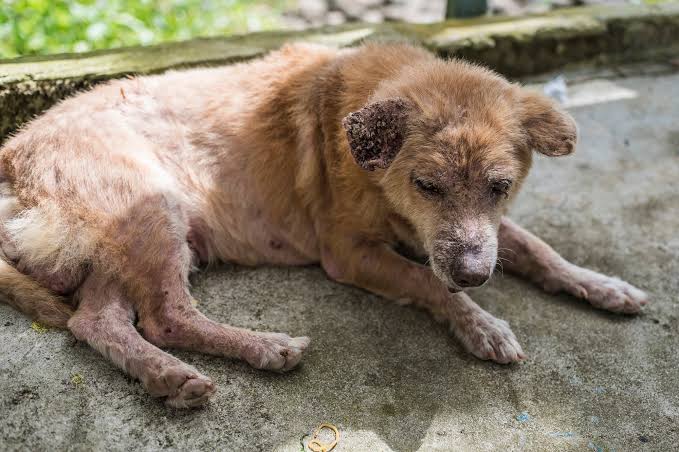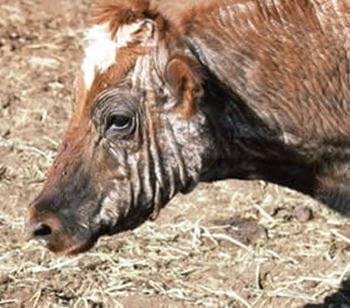Sarcoptic mange, also known as scabies, is a skin condition caused by a tiny mite called Sarcoptes scabiei. These microscopic creatures burrow into the skin, causing intense itching and discomfort. The scientific name for the mite responsible is Sarcoptes scabiei var. hominis when affecting humans.
Scabies is highly contagious and can spread through close personal contact or by sharing personal items such as clothing or bedding with an infected individual. The mites thrive in warm, humid environments and can survive for a short period away from the human host.
The hallmark symptom of sarcoptic mange is itching, which often becomes more severe at night. The mites create burrows in the skin where they lay eggs, leading to the development of small, itchy red bumps and rashes. Scratching these affected areas can result in secondary bacterial infections.
While scabies can affect people of all ages and backgrounds, it is often found in crowded living conditions, such as nursing homes, prisons, or refugee camps. However, anyone can contract scabies, regardless of socioeconomic status.
Diagnosing scabies typically involves a healthcare professional examining the skin and, if necessary, performing a skin scraping to identify mites or their eggs under a microscope. Treatment usually involves topical medications, such as permethrin or ivermectin, to eliminate the mites.
Preventing the spread of scabies involves practicing good hygiene, avoiding close contact with infected individuals, and regularly washing personal items like clothing and bedding. It’s important to treat all household members if one person is diagnosed with scabies to prevent reinfection.
However, sarcoptic mange, or scabies, is a skin condition caused by the Sarcoptes scabiei mite. It is highly contagious and characterized by intense itching and skin rashes. Early diagnosis and prompt treatment are crucial to preventing the spread of scabies and managing its symptoms. Practicing good hygiene and taking preventive measures can help reduce the risk of contracting or spreading this bothersome skin condition.
Read Also: How to Grow Cauliflower
Animals Affected by Sarcoptic Mange (scabies)

Sarcoptic mange, or scabies, is not exclusive to humans; it can affect a variety of animals. The Sarcoptes scabiei mite has different variations that specifically target various hosts. Here are some animals commonly affected by sarcoptic mange:
1. Dogs (Canines): Canine scabies, caused by Sarcoptes scabiei var. canis, is prevalent among dogs. It results in intense itching, hair loss, and the formation of crusty lesions. Infected dogs may scratch excessively, and the condition can be transmitted to other pets or humans through close contact.
2. Cats (Felines): Feline scabies, caused by Sarcoptes scabiei var. felis, affects cats. Symptoms include itching, crusty skin, and small red bumps. Cats may develop scabies from contact with other infected animals, making it crucial to isolate and treat affected pets.
3. Pigs (Swine): Sarcoptic mange in pigs is caused by Sarcoptes scabiei var. suis. Infected pigs may experience intense itching, leading to skin lesions and hair loss. This form of mange can have economic implications in swine farming due to reduced productivity and compromised health.
4. Foxes: Wild animals, including foxes, can harbor sarcoptic mange. Foxes infected with Sarcoptes scabiei may exhibit symptoms such as severe itching, hair loss, and thickened skin. Transmission can occur through direct contact or environmental exposure.
5. Cattle: Sarcoptic mange in cattle is caused by Sarcoptes scabiei var. bovis. Infected cattle may display signs of itching, restlessness, and hair loss. The condition can affect milk production and overall herd health.
6. Sheep and Goats: Sarcoptic mange in small ruminants is caused by Sarcoptes scabiei var. ovis. Infestations can lead to wool loss, weight loss, and reduced wool quality in sheep. Goats may experience similar symptoms, impacting their overall health and productivity.
7. Wildlife: Various wild animals, including deer, rabbits, and rodents, can be affected by sarcoptic mange. In wildlife populations, sarcoptic mange can have significant ecological implications, impacting individual animals and potentially affecting entire ecosystems.
Understanding the range of hosts susceptible to sarcoptic mange is crucial for both veterinary professionals and individuals involved in animal care. Timely diagnosis and appropriate treatment are essential to prevent the spread of the condition within animal populations and minimize its impact on their health and well-being.
Damages Caused by Sarcoptic Mange (scabies)

Sarcoptic mange, or scabies, can inflict various damages on both humans and animals, affecting their health and well-being. Here are the potential damages caused by sarcoptic mange:
1. Intense Itching: The hallmark symptom of sarcoptic mange is severe itching. This persistent itching can lead to discomfort and interfere with daily activities, affecting the quality of life for both humans and animals.
2. Skin Lesions and Rashes: As the Sarcoptes scabiei mites burrow into the skin to lay eggs, it results in the formation of burrows and small red bumps. Continuous scratching can lead to open sores, crusty skin, and secondary bacterial infections.
3. Hair Loss: Mange infestations often cause significant hair loss, leading to bald patches on the skin. This can impact the appearance of affected individuals and may result in additional discomfort due to exposed skin.
4. Restlessness and Agitation: Animals suffering from sarcoptic mange may exhibit behavioral changes such as restlessness, agitation, or increased irritability. These changes can affect their overall well-being and may impact their interactions with humans and other animals.
5. Weight Loss and Reduced Productivity: In agricultural settings, sarcoptic mange in livestock, such as pigs, cattle, sheep, and goats, can lead to weight loss and reduced productivity. Infected animals may experience a decline in growth rates, milk production, or wool quality, affecting economic outcomes for farmers.
6. Transmission to Humans and Other Animals: Scabies is highly contagious. If left untreated, it can be transmitted from person to person or between animals, leading to the potential for widespread infestations in households, farms, or wildlife populations.
7. Compromised Immune System: Prolonged infestations with sarcoptic mange can weaken the immune system of affected individuals. This makes them more susceptible to secondary infections and may exacerbate existing health conditions.
8. Economic Impact: In agricultural and livestock industries, sarcoptic mange can have economic consequences due to reduced productivity, treatment costs, and potential impacts on market value.
Understanding the damages caused by sarcoptic mange underscores the importance of prompt diagnosis and treatment. Early intervention can help alleviate symptoms, prevent the spread of infestations, and mitigate the potential long-term effects on the health and well-being of both humans and animals.
Read Also: How to Grow Broccoli
Control and Preventive Measures

Control and preventive measures are crucial in managing and minimizing the spread of sarcoptic mange (scabies) among humans and animals. Here are key strategies:
1. Isolation and Quarantine:
Humans: Infected individuals should avoid close contact with others until the infestation is treated.
Animals: Isolate infected animals from healthy ones to prevent the spread of mites.
2. Personal Hygiene:
Humans: Maintain good personal hygiene, including regular handwashing, to reduce the risk of transmission.
Animals: Regular grooming and cleaning of animal living spaces can help reduce mite populations.
3. Medical Treatment:
Humans: Seek medical attention for diagnosis and appropriate treatment, often involving topical medications like permethrin or oral medications like ivermectin.
Animals: Consult a veterinarian for the proper diagnosis and treatment. Treat affected animals promptly with approved medications.
4. Environmental Cleaning:
Humans: Wash bedding, clothing, and personal items regularly, and vacuum living spaces to remove mites.
Animals: Clean and disinfect animal enclosures, bedding, and surrounding areas to eliminate mites and prevent reinfestation.
5. Avoiding Shared Items:
Humans: Avoid sharing personal items such as clothing, towels, and bedding, especially in crowded living conditions.
Animals: Prevent the sharing of grooming tools, bedding, and other items among animals to minimize the risk of transmission.
6. Education and Awareness:
Humans: Educate communities about the signs, symptoms, and preventive measures of scabies to promote early detection and treatment.
Animal Owners: Raise awareness about sarcoptic mange, emphasizing the importance of veterinary care and preventive measures.
7. Treatment of Contacts:
Humans: Treat all close contacts, even if they do not show symptoms, to prevent the spread of scabies.
Animals: Treat all animals in a group or herd, even those without visible signs of sarcoptic mange, to prevent further infestations.
8. Biosecurity Measures:
Farms and Animal Facilities: Implement biosecurity measures to prevent the introduction of mites to animal populations.
Healthcare Facilities: Follow infection control protocols to minimize the risk of scabies transmission in healthcare settings.
9. Wildlife Management: Implement measures to control sarcoptic mange in wildlife populations, which can serve as reservoirs for the mites.
10. Regular Monitoring: Keep a vigilant eye on both human and animal populations for signs of scabies. Early detection and intervention are key to effective control.
Implementing a combination of these measures is essential for comprehensive control and prevention of sarcoptic mange, contributing to the well-being of both humans and animals.
Frequently Asked Questions (FAQs) About Sarcoptic Mange (scabies)
Q1: What is sarcoptic mange (scabies)?
A: Sarcoptic mange, commonly known as scabies, is a skin infestation caused by the Sarcoptes scabiei mite. It leads to intense itching, rashes, and skin lesions.
Q2: How is sarcoptic mange transmitted?
A: Sarcoptic mange is primarily transmitted through close personal contact with an infected individual. It can also spread by sharing personal items like clothing or bedding.
Q3: What are the symptoms of sarcoptic mange in humans?
A: Symptoms include severe itching, especially at night, red bumps, rashes, and the development of burrows on the skin where mites lay eggs.
Q4: Can animals get sarcoptic mange?
A: Yes, various animals, including dogs, cats, pigs, cattle, and wildlife, can be affected by sarcoptic mange. Each species may have its own specific variation of the mite.
Q5: How is sarcoptic mange diagnosed?
A: Diagnosis often involves a healthcare professional examining the skin and, if necessary, performing a skin scraping to identify mites or their eggs under a microscope.
Q6: What is the treatment for sarcoptic mange?
A: Treatment typically involves topical medications like permethrin or oral medications like ivermectin. It is crucial to follow medical or veterinary advice for proper treatment.
Q7: Can sarcoptic mange be prevented?
A: Yes, preventive measures include good personal hygiene, avoiding close contact with infected individuals or animals, regular cleaning of living spaces, and prompt treatment of infestations.
Q8: Is sarcoptic mange contagious?
A: Yes, sarcoptic mange is highly contagious. Close contact with an infected person or animal or sharing personal items can lead to transmission.
Q9: Can you get scabies from animals?
A: Yes, humans can get scabies from infested animals. However, each species typically has its own specific variation of the Sarcoptes scabiei mite.
Q10: Can sarcoptic mange go away on its own?
A: Sarcoptic mange rarely resolves on its own. Treatment is usually necessary to eliminate the mites and alleviate symptoms. Seeking medical or veterinary advice is recommended.
Read Also: Potato Farming Guide – 7 Tips to Grow Sacks Full of Potatoes

